|

September 26, 2013
from
NASA Website
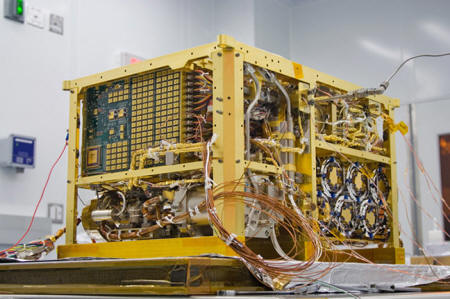
SAM before
installation on Curiosity
The Sample Analysis at Mars instrument suite,
prior to its
installation on the Curiosity rover.
Image Credit: NASA Goddard
The
first scoop of soil analyzed in the
belly of the
Curiosity
rover on Mars reveals that fine
materials on
the surface
of the planet contain
several
percent water by weight.
The results were published September 25 in Science as one article in
a five-paper special section on the
Curiosity mission.
"One of the most exciting results
from this very first solid sample ingested by Curiosity is the
high percentage of water in the soil," said Laurie Leshin, lead
author of one paper and dean of the School Science at Rensselaer
Polytechnic Institute.
"About 2 percent of the soil on the
surface of Mars is made up of water, which is a great resource,
and interesting scientifically."
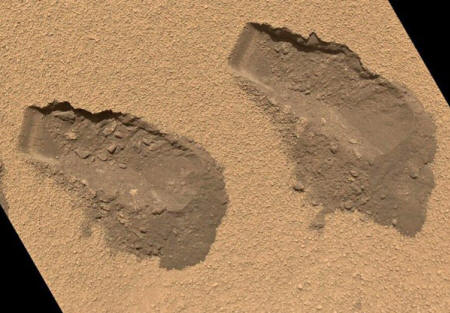
The Sample Analysis
at Mars instrument suite found
water in the dust,
dirt and fine soil from the Rocknest site on Mars.
(This file photo
shows trenches Curiosity dug in October 2012.)
Image Credit:
NASA/JPL-Caltech/MSSS
Curiosity landed in
Gale Crater on the surface of Mars
on Aug. 6, 2012, charged with answering the question:
"Could Mars have once harbored
life?"
To do that, Curiosity is the first rover
on Mars to carry equipment for gathering and processing samples of
rock and soil.
One of those instruments was employed in
the current research: the Sample Analysis at Mars (SAM)
instrument suite, which includes a gas chromatograph, a mass
spectrometer and a tunable laser spectrometer.
These tools enable SAM to identify a
wide range of chemical compounds and determine the ratios of
different isotopes of key elements.
"This work not only demonstrates
that SAM is working beautifully on Mars, but also shows how SAM
fits into Curiosity’s powerful and comprehensive suite of
scientific instruments," said Paul Mahaffy, principal
investigator for SAM at NASA’s Goddard Space Flight Center in
Greenbelt, Md.
"By combining analyses of water and
other volatiles from SAM with mineralogical, chemical and
geological data from Curiosity’s other instruments, we have the
most comprehensive information ever obtained on Martian surface
fines. These data greatly advance our understanding surface
processes and the action of water on Mars."
Thirty-four researchers, all members of
the Mars Science Laboratory Science Team, contributed to the paper.
In this study, scientists used the rover’s scoop to collect dust,
dirt and finely grained soil from a sandy patch
known as Rocknest.
Researchers fed portions of the fifth
scoop into SAM.
Inside SAM, the "fines" - the dust, dirt
and fine soil - were heated to 1,535 degrees F (835° C).
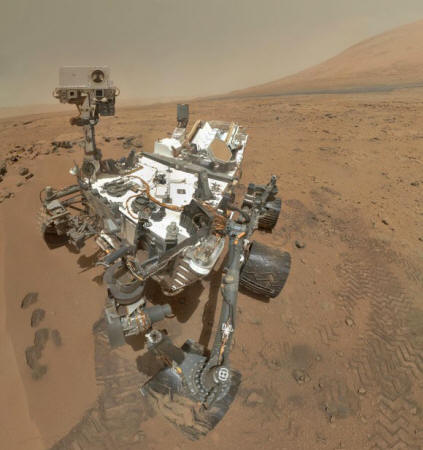
Mosaic image of
Curiosity.
Image Credit: NASA/JPL-Caltech/Malin Space Science Systems
Baking the sample also revealed a compound containing chlorine and
oxygen, likely
chlorate or
perchlorate, previously found near
the north pole on Mars.
Finding such compounds at Curiosity’s
equatorial site suggests they could be distributed more globally.
The analysis also suggests the presence of carbonate materials,
which form in the presence of water.
In addition to determining the amount of the major gases released,
SAM also analyzed ratios of isotopes of hydrogen and carbon in the
released water and carbon dioxide. Isotopes are variants of the same
chemical element with different numbers of neutrons, and therefore
different atomic weights.
SAM found that the ratio of some
isotopes in the soil is similar to the ratio found in atmospheric
samples analyzed earlier, indicating that the surface soil has
interacted heavily with the atmosphere.
"The isotopic ratios, including
hydrogen-to-deuterium ratios and carbon isotopes, tend to
support the idea that as the dust is moving around the planet,
it’s reacting with some of the gases from the atmosphere,"
Leshin said.
SAM can also search for trace levels of
organic compounds.
Although several simple organic
compounds were detected in the experiments at Rocknest, they aren’t
clearly Martian in origin. Instead, it is likely that they formed
during the high-temperature experiments, when the heat decomposed
perchlorates in the Rocknest samples, releasing oxygen and chlorine
that then reacted with terrestrial organics already present in the
SAM instrument.
A related paper, published in the Journal of Geophysical
Research-Planets, details the findings of perchlorates and other
chlorine-bearing compounds in the Rocknest sample.
This paper is led by Daniel Glavin,
a Mars Science Laboratory Science Team member at Goddard.
Glavin notes that SAM has the ability to perform another kind of
experiment to address the question of whether organic molecules are
present in the Martian samples.
The SAM suite includes nine fluid-filled
cups which hold chemicals that can react with organic molecules if
present in the soil samples.
"Because these reactions occur at
low temperatures, the presence of perchlorates will not inhibit
the detection of Martian organic compounds," said Glavin.
The combined results shed light on the
composition of the planet’s surface, while offering direction for
future research.
"Mars has kind of a global layer, a
layer of surface soil that has been mixed and distributed by
frequent dust storms. So a scoop of this stuff is basically a
microscopic Mars rock collection," said Leshin.
"If you mix many grains of it
together, you probably have an accurate picture of typical
Martian crust. By learning about it in any one place you’re
learning about the entire planet."
NASA’s Curiosity Finds...
Water Molecules on Mars
September 27, 2013
from
SciTechDaily Website
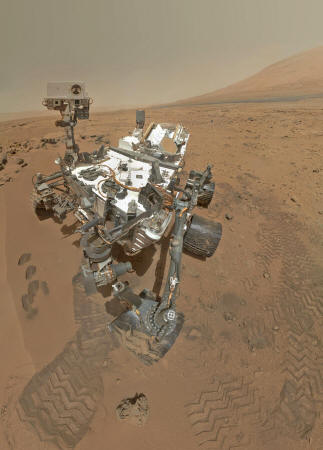
On Sol 84 (Oct. 31,
2012), NASA’s Curiosity rover
used the Mars Hand
Lens Imager (MAHLI) to capture this
set of 55
high-resolution images, which were stitched together
to create this
full-color self-portrait.
Image Credit:
NASA/JPL-Caltech/Malin Space Science Systems
Analysis
of the Martian soil samples
taken by NASA’s
Curiosity rover
has reveal that
water molecules are bound
to fine-grained
soil particles, accounting for
about 2 percent
of the particles’ weight
at Gale Crater
where Curiosity landed.
Pasadena, California
NASA’s Curiosity rover is revealing a
great deal about Mars, from long-ago processes in its interior to
the current interaction between the Martian surface and atmosphere.
Examination of loose rocks, sand and dust has provided new
understanding of the local and global processes on Mars.
Analysis of
observations and measurements by the rover’s science instruments
during the first four months after the August 2012 landing are
detailed
in five reports in the September 27 edition of the journal
Science.
A key finding is that water molecules are bound to fine-grained soil
particles, accounting for about 2 percent of the particles’ weight
at Gale Crater where Curiosity landed.
This result has global implications,
because these materials are likely distributed around the 'Red
Planet.'
Curiosity also has completed the first comprehensive mineralogical
analysis on another planet using a standard laboratory method for
identifying minerals on Earth.
The findings about both crystalline
and non-crystalline components in soil provide clues to the planet’s
'volcanic' history.
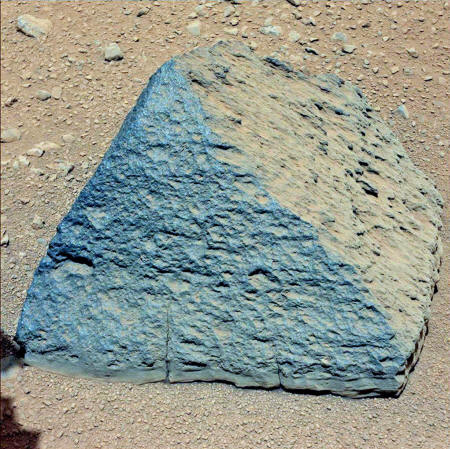
Curiosity Finds Water Molecules Bound to Fine Grained Soil Particles
This image shows where NASA’s Curiosity rover
aimed two different
instruments to study a rock
known as "Jake
Matijevic."
Image Credit:
NASA/JPL-Caltech/MSSS
Information about the evolution of the Martian crust and deeper
regions within the planet comes from Curiosity’s mineralogical
analysis of a football-size igneous rock called "Jake M."
Igneous rocks form by cooling molten
material that originated well beneath the crust.
The chemical
compositions of the rocks can be used to infer the thermal, pressure
and chemical conditions under which they crystallized.
"No other Martian rock is so similar
to terrestrial igneous rocks," said Edward Stolper of the
California Institute of Technology, lead author of a report
about this analysis.
"This is surprising because
previously studied igneous rocks from Mars differ substantially
from terrestrial rocks and from Jake M."
The other four reports include analysis
of the composition and formation process of a windblown drift of
sand and dust, by David Blake of NASA’s Ames Research Center
at Moffett Field, California, and co-authors.
Curiosity examined this drift, called
Rocknest, with five
instruments, preforming an onboard laboratory analysis of samples
scooped up from the Martian surface. The drift has a complex history
and includes sand particles with local origins, as well as finer
particles that sample windblown Martian dust distributed regionally
or even globally.
The rover is equipped with a laser instrument to determine material
compositions from some distance away. This instrument found that the
fine-particle component in the Rocknest drift matches the
composition of windblown dust and contains water molecules.
The rover tested 139 soil targets at
Rocknest and elsewhere during the mission’s first three months and
detected hydrogen - which scientists interpret as water - every time
the laser hit fine-particle material.
"The fine-grain component of the
soil has a similar composition to the dust distributed all
around Mars, and now we know more about its hydration and
composition than ever before," said Pierre-Yves Meslin of the
Institut de Recherche en Astrophysique et Planétologie in
Toulouse, France, lead author of a report about the laser
instrument results.
A laboratory inside Curiosity used
X-rays to determine the composition of Rocknest samples.
This technique, discovered in 1912, is a
laboratory standard for mineral identification on Earth. The
equipment was miniaturized to fit on the spacecraft that carried
Curiosity to Mars, and this has yielded spinoff benefits for similar
portable devices used on Earth.
David Bish of Indiana University
in Bloomington co-authored a report about how this technique was
used and its results at Rocknest.
X-ray analysis not only identified 10 distinct minerals, but also
found an unexpectedly large portion of the Rocknest composition is
amorphous ingredients, rather than crystalline minerals. Amorphous
materials, similar to glassy substances, are a component of some
volcanic deposits on Earth.
Another laboratory instrument identified chemicals and isotopes in
gases released by heating the Rocknest soil in a tiny oven. Isotopes
are variants of the same element with different atomic weights.
These tests found water makes up about 2
percent of the soil, and the water molecules are bound to the
amorphous materials in the soil.
"The ratio of hydrogen isotopes in
water released from baked samples of Rocknest soil indicates the
water molecules attached to soil particles come from interaction
with the modern atmosphere," said Laurie Leshin of Rensselaer
Polytechnic Institute in Troy, New York, lead author of a report
about analysis with the baking instrument.
Baking and analyzing the Rocknest sample
also revealed a compound with chlorine and oxygen, likely chlorate
or perchlorate, which previously was known to exist on Mars only at
one high-latitude site.
This finding at Curiosity’s equatorial
site suggests more global distribution.
Data obtained from Curiosity since the first four months of the
rover’s mission on Mars are still being analyzed. NASA’s Jet
Propulsion Laboratory (JPL), a division of Caltech in Pasadena,
California, manages the mission for NASA’s Science Mission
Directorate in Washington.
The mission draws upon international
collaboration, including key instrument contributions from Canada,
Spain, Russia and France.
Publications
-
E. M. Stolper, et al.,
"The Petrochemistry of Jake_M: A Martian Mugearite," Science
27 September 2013: Vol. 341 no. 6153;
DOI: 10.1126/science.1239463
-
L. A. Leshin, et al.,
"Volatile, Isotope, and Organic Analysis of Martian Fines
with the Mars Curiosity Rover," Science 27 September 2013:
Vol. 341 no. 6153;
DOI: 10.1126/science.1238937
-
John P. Grotzinger,
"Analysis of Surface Materials by the Curiosity Mars Rover,"
Science 27 September 2013: Vol. 341 no. 6153 p. 1475;
DOI: 10.1126/science.1244258
-
D. F. Blake, et al.,
"Curiosity at Gale Crater, Mars: Characterization and
Analysis of the Rocknest Sand Shadow," Science 27 September
2013: Vol. 341 no. 6153;
DOI: 10.1126/science.1239505
-
D. L. Bish, et al., "X-ray
Diffraction Results from Mars Science Laboratory: Mineralogy
of Rocknest at Gale Crater," Science 27 September 2013: Vol.
341 no. 6153;
DOI: 10.1126/science.1238932
-
P.-Y. Meslin, et al.,
"Soil Diversity and Hydration as Observed by ChemCam at Gale
Crater, Mars," Science 27 September 2013: Vol. 341 no. 6153;
DOI: 10.1126/science.1238670
|





